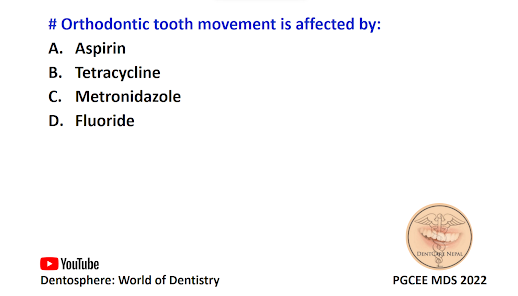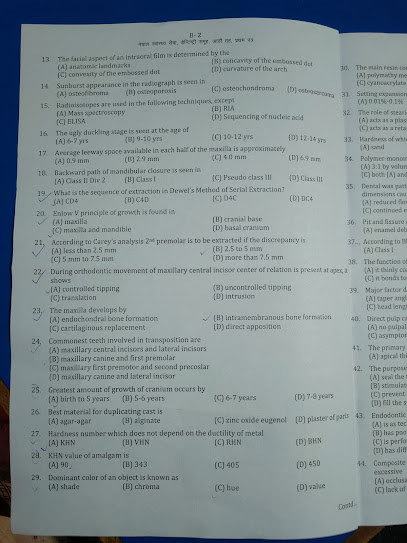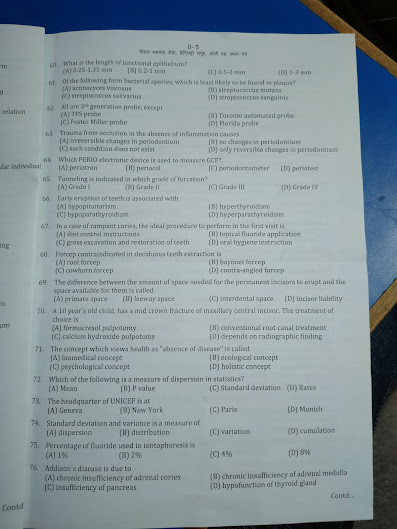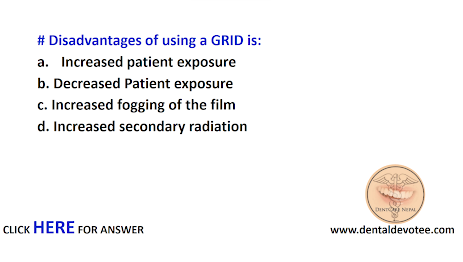1. Most accepted theory for the conduction of pain is:
5. Local anesthetic agent is absolutely contraindicated in:
(A) hyperthyroidism
(B) bronchial asthma
(C) diabetes mellitus
(D) hypertension
6. The deficiency of which of the following does not affect on tooth development?
(A) Vitamin A
(B) Vitamin D
(C) Vitamin C
(D) Vitamin K
7. Pindborg tumour arises from:
(A) basal layer of cells
(B) stratum intermedium
(C) stratum corneum
(D) dental lamina
8. Pinpoint hemorrhage of less than 1 cm diameter are known as:
(A) petechiae
(B) echymoses
(C) pinpura
(D) pustules
9. Precancerous potential in plummer vinson syndrome may be due to change in the epithelium like:
(A) atrophy
(B) hypertrophy
(C) acanthosis
(D) juxta epithelial hyalinization
10. One of the common side effects of dilantin sodium therapy seen in oral cavity is:
(A) stains on teeth
(B) hairy tongue
(C) gingival hyperplasia
(D) gingival recession
11. Palatal lesion with multinodular appearance with a red spot seen in centre is:
(A) Smoker's palate
(B) Leukoplakia
(C) OSMF
(D) Erythroplakia
12. Radiographic view for diagnosing horizontally favorable and unfavorable fractures of mandible is best seen in:
(A) OPG
(B) Lateral oblique view
(C) Reverse town's
(D) Transpharyngeal
13. The facial aspect of an intraoral film is determined by the:
(A) anatomic landmarks
(B) concavity of the embossed dot
(C) convexity of the embossed dot
(D) curvature of the arch
14. Sunburst appearance in the radiograph is seen in:
(A) osteofibroma
(B) osteoporosis
(C) osteochondroma
(D) osteosarcoma
15. Radioisotopes are used in the following techniques, except:
(A) Mass spectroscopy
(B) RIA
(C) ELISA
(D) Sequencing of nucleic acid
16. The ugly duckling stage is seen at the age of:
(A) 6-7 yrs
(B) 9-10 yrs
(C) 10-12 yrs
(D) 12-14 yrs
17. Average leeway space available in each half of the maxilla is approximately:
(A) 0.9 mm
(B) 2.9 mm
(C) 4.0 mm
(D) 6.9 mm
18. Backward path of mandibular closure is seen in:
(A) Class II Div 2
(B) Class I
(C) Pseudo class III
(D) Class III
19. What is the sequence of extraction in Dewel's Method of Serial Extraction?
(A) CD4
(B) C4D
(C) D4C
(D) DC4
20. Enlow V principle of growth is found in:
(A) maxilla
(B) cranial base
(C) maxilla and mandible
(D) basal cranium
21. According to Carey's analysis 2nd premolar is to be extracted if the discrepancy is:
(A) less than 2.5 mm
(B) 2.5 to 5 mm
(C) 5 mm to 7.5 mm
(D) more than 7.5 mm
22. During orthodontic movement of maxillary central incisor center of relation is present at apex, it shows:
(A) controlled tipping
(B) uncontrolled tipping
(C) translation
(D) intrusion
23. The maxilla develops by:
(A) endochondral bone formation
(B) intramembranous bone formation
(C) cartilaginous replacement
(D) direct apposition
24. Commonest teeth involved in transposition are:
(A) maxillary central incisors and lateral incisors
(B) maxillary canine and first premolar
(C) maxillary first premolar and second premolar
(D) maxillary canine and lateral incisor
25. Greatest amount of growth of cranium occurs by:
(A) birth to 5 years
(B) 5-6 years
(C) 6-7 years
(D) 7-8 years
26. Best material for duplicating cast is:
(A) agar-agar
(B) alginate
(C) zinc oxide eugenol
(D) plaster of paris
27. Hardness number which does not depend on the ductility of metal:
(A) KHN
(B) VHN
(C) RUN
(D) BHN
28. KHN value of amalgam is:
(A) 90
(B) 343
(C) 405
(D) 450
29. Dominant color of an object is known as:
(A) shade
(B) chroma
(C) hue
(D) value
30. The main resin constituent of polishable composite resin is:
(A) polymethyl methacrylate
(B) polycarbonate
(C) cyanoacrylate
(D) dimethacrylate
31. Setting expansion of dental stone is:
(A) 0.01%-0.1%
(B) 0.06%-0.12%
(C) 0.5%-0.1%
(D) 0.05%-0.5%
32. The role of stearic acid in impression compound:
(A) acts as a plasticizer
(B) acts as an accelerator
(C) acts as a retarder
(D) acts as a filler
33. Hardness of which of the following abrasives is maximum:
(A) sand
(B) emery
(C) boron carbide
(D) silicon carbide
34. Polymer-monomer proportion of polymethyl acrylate is:
(A) 3:1 by volume
(B) 2:1 by weight
(C) both (A) and (B)
(D) none of the above
35. Dental wax patterns should be invested as soon as possible in order to minimize change in dimensions caused by:
(A) reduced flow
(B) water absorption
(C) continued expansion of wax
(D) relaxation of internal stress
36. Pit and fissure caries is seen in: (Question Asked with wrong options, this is corrected)
a) Class I
b) Class I compound
c) Class II
d) Class II compound
37. According to Black's classification, caries on lingual pits of maxillary central incisors are:
(A) Class I
(B) Class II
(C) Class III
(D) Class IV
38. The function of dentin conditioner is:
(A) it thinly coats collagen fibrils with resin
(B) it thickly coats collagen fibrils with resin
(C) it bonds to composite
(D) it removes the smear layer
39. Major factor determining the efficiency of the bur is:
(A) taper angle
(B) spiral angle
(C) head length
(D) head diameter
40. Direct pulp capping is indicated in:
(A) no pulpal exposure
(B) symptomatic pin point pulpal exposure
(C) asymptomatic pinpoint pulpal exposure
(D) asymptomatic irreversible pulpitis
41. The primary gutta percha cone must fill the canal wall tightly in the:
(A) apical third
(B) middle third
(C) cervical third
(D) entire canal
42. The purpose of root canal sealer is to:
(A) seal the tubular of dentines
(B) stimulate healing in periapical region
(C) prevent discoloration
(D) fill the space between solid core material and pulp canal walls
43. Endodontic retreatment:
(A) is as technically challenging as original treatment
(B) has poorer prognosis than original treatment
(C) is performed only on endodontic failures
(D) has different objectives than primary treatment
44. Composite resins are not usually recommended for restoration of class II cavities because of excessive:
(A) occlusal wear
(B) marginal fracture
(C) lack of color stability
(D) isthmus fracture
45. A casting is maintained in position under masticatory load primarily by virtue of:
(A) cement seal
(B) retention and resistance form
(C) obtuse cavosurface angle
(D) all of the above
46. Average root surface area of maxillary first molar is:
(A) 433
(B) 431
(C) 426
(D) 400
47. Hinge axis located with the help of:
(A) ear rods
(B) maxilla mandibular vertical relation
(C) kinematic face-bow
(D) orbital pointer
48. Pontic should be:
(A) convex buccolingually
(B) convex mesiodistally
(C) convex buccolingually and concave
(D) concave mesiodistally
49. Vertical dimension at rest (VDR) is:
(A) changes throughout life
(B) remains constant for particular individual
(C) less than vertical dimension at occlusion
(D)similar to the freeway space
50. Objective of full mouth rehabilitation is:
(A) to treat periodontal conditions
(B) to minimize undue destructive stress to the tissues
(C) to replace lost teeth
(D) to bring in proper occlusion
51. Kennedy classification is determined by:
(A) the most anterior tooth missing
(B) the first tooth to be lost
(C) the largest tooth in the space
(D) the most posterior tooth missing
52. The position of the upper occlusal rim in the articulator is adjusted by :
(A) arbitrary means
(B) using face-bow
(C) visual examination
(D) adjusting the incisal pin
53. A sprue in a wax pattern show be placed:
(A) at right angle
(B) at acute angle
(C) at obtuse angle
(D) depends on types of wax pattern
54. Thickness of the die spacer should be:
(A) 10-20 micrometer
(B) 20-40 micrometer
(C) 40-60 micrometer
(D) 66-80 micrometer
55. The secondary peripheral seal area of mandibular complete denture is the:
(A) labial border
(B) buccal border
(C) distolingual border
(D) anterior lingual border
56. Pocket elimination and increase in width of attached gingiva is obtained by:
(A) modified Widman's flap
(B) apically displaced flap
(C) laterally displaced flap
(D) papilla preservation flap
57. Principal cell type of periodontal ligament is:
(A) fibroblasts
(B) osteoblasts
(C) epithelial rest cells of Malassez
(D) cementoblasts
58. Periodontal flap surgery is most difficult in:
(A) incisors (facially)
(B) incisors (lingually)
(C) 2nd molars (facially)
(D) 2nd molars (distally)
59. The brushing technique recommended for patients with periodontal disease is:
(A) scrub technique
(B) sulcular technique
(C) roll technique
(D) circular technique
60. What is the length of junctional epithelium?
(A) 0.25-1.35 mm
(B) 0.2-1 mm
(C) 0.5-2 mm
(D) 1-3 mm
61. Of the following form bacterial species, which is least likely to be found in plaque?
(A) Actinomyces viscosus
(B) Streptococcus mutans
(C) Streptococcus salivarius
(D) Streptococcus sanguinis
62. All are 3rd generation probe, except:
(A) TPS probe
(B) Toronto automated probe
(C) Foster Miller probe
(D) Florida probe
63. Trauma from occlusion in the absence of inflammation causes:
(A) irreversible changes in periodontium
(B) no changes in periodontium
(C) such condition does not exist
(D) only reversible changes in periodontium
64. Which PERIO electronic device is used to measure GCF?
(A) periotron
(B) periocol
(C) periodontometer
(D) periotest
65. Tunneling is indicated in which grade of furcation?
(A) Grade I
(B) Grade II
(C) Grade III
(D) Grade IV
66. Early eruption of teeth is associated with:
(A) hypopituitarism
(B) hyperthyroidism
(C) hypoparathyroidism
(D) hyperparathyroidism
67. In a case of rampant caries, the ideal procedure to perform in the first visit is:
(A) diet control instructions
(B) topical fluoride application
(C) gross excavation and restoration of teeth
(D) oral hygiene instruction
68. Forcep contraindicated in deciduous teeth extraction is:
(A) root forcep
(B) bayonet forcep
(C) cowhorn forcep
(D) contra-angled forcep
69. The difference between the amount of space needed for the permanent incisors to erupt and the space available for them is called:
(A) primate space
(B) leeway space
(C) interdental space
(D) incisor liability
70. A 10 year old child, has a mid crown fracture of maxillary central incisor. The treatment of choice is:
(A) formocresol pulpotomy
(B) conventional root canal treatment
(C) calcium hydroxide pulpotomy
(D) depends on radiographic finding
71. The concept which views health as "absence of disease" is called:
(A) biomedical concept
(B) ecological concept
(C) psychological concept
(D) holistic concept
72. Which of the following is a measure of dispersion in statistics?
(A)Mean
(B) P value
(C) Standard deviation
(D) Rates
73. The headquarter of UNICEF is at:
(A)Geneva
(B) New York
(C) Paris
(D) Munich
74. Standard deviation and variance is a measure of:
(A) dispersion
(B) distribution
(C) variation
(D) cumulation
75. Percentage of fluoride used in iontophoresis is:
(A) 1%
(B) 2%
(C) 4%
(D) 8%
76. Addison's disease is due to:
(A) chronic insufficiency of adrenal cortex
(B) chronic insufficiency of adrenal medulla
(C) insufficiency of pancreas
(D) hypofunction of thyroid gland
77. Spontaneous bleeding usually seen with a platelet count of:
(A) less than 50000/cubic mm
(B) 5000-75000/cubic mm
(C) 75000-100000/cubic mm
(D) 100000-150000/cubic mm
78. Acetone breaths is feature of:
(A) liver disease
(B) sinusitis
(C) renal disease
(D) diabetes mellitus
79. The appropriate test which shows lack of intrinsic factor in Vitamin B12 deficiency is:
(A) full blood count
(B) schilling's test
(C) bence Jones protein
(D) ferritin
80. Which among the following is elevated in hemophilia A?
(A) PT
(B) CT
(C) APTT
(D) PT and APTT
81. Which of the following drug is used in the treatment of hyperkalemia in acute renal failure?
(A) Amiloride
(B) Amlodipine
(C) Captopril
(D) Insulin
82. The suture that maintains strength for longest time is:
(A) Dexon
(B) Vicryl
(C) PDS
(D) Chromic catgut
83. Most common primary bone tumor is:
(A) Osteosarcoma
(B) Multiple myeloma
(C) Enchondroma
(D) Ewing's sarcoma
84. The carotid body is a:
(A) pressure receptor
(B) pH receptor
(C) osmo receptor
(D) chemo receptor
85. A punched out edge is characteristic of which type of ulcer?
(A) Tuberculosis
(B) Rodent ulcer
(C) Syphilitic ulcer
(D) Nonspecific ulcer
86. Which form of actinomycosis is most common?
(A) Faciocervical
(B) Thorax
(C) Liver
(D) Spleen
87. Nasopharyngeal carcinoma mostly arises from:
(A) roof
(B) posterior wall
(C) anterior wall
(D) fossa of Rosenmuller
88. The excessive formation of scar tissue is called:
(A) fibroma
(B) myxoma
(C) myoma
(D) keloid
89. Which of the cells most commonly found in granuloma?
(A) Lymphocytes
(B) Giant cells
(C) Mast cells
(D) Neutrophils
90. Long term effect of radiotherapy to oral mucosa is characterized by:
(A) epithelium becomes more keratinized
(B) sub mucosa becomes highly vascular
(C) break down and delayed healing, sub mucosa less vascular
(D) no sub mucosal fibrosis
91. A multilocular cyst of the jaw is more likely:
(A) dental cyst
(B) dentigerous cyst
(C) keratocyst
(D) simple bone cyst
92. "Onion peel" radiographic appearance is seen in:
(A) Ewing's sarcoma
(B) Pagets disease
(C) Fibrous dysplasia
(D) Osteogenesis imperfecta
93. Which one of following type of nevi do not occur in oral cavity?
(A) Intradermal
(B) Junctional
(C) Spindle cell
(D) Blue nevus
94. Odontolithiasis is better known as:
(A) plaque
(B) calculus
(C) salivary calculi
(D) caries
95. The chemical disintegration of enamel is referred to as:
(A) abrasion
(B) attrition
(C) erosion
(D) hypoplasia
96. Fracture of condyle causes:
(A)deviation to affected side
(B) deviation to opposite side
(C) no movement
(D) normal functioning
97. According to "fusion theory", cleft lip occurs due to failure of:
(A) fusion of median nasal process with maxillary process
(B) fusion of median nasal process and lateral nasal process
(C) fusion of maxillary and lateral nasal process
(D) fusion of median nasal process









































